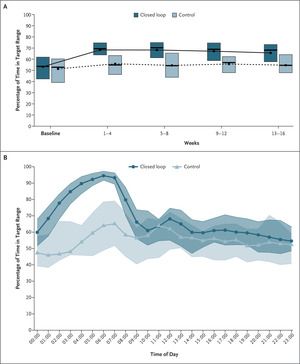BACKGROUND
A closed-loop system of insulin delivery (also called an artificial pancreas) may improve glycemic outcomes in children with type 1 diabetes.
METHODS
In a 16-week, multicenter, randomized, open-label, parallel-group trial, we assigned, in a 3:1 ratio, children 6 to 13 years of age who had type 1 diabetes to receive treatment with the use of either a closed-loop system of insulin delivery (closed-loop group) or a sensor-augmented insulin pump (control group). The primary outcome was the percentage of time that the glucose level was in the target range of 70 to 180 mg per deciliter, as measured by continuous glucose monitoring.
RESULTS
A total of 101 children underwent randomization (78 to the closed-loop group and 23 to the control group); the glycated hemoglobin levels at baseline ranged from 5.7 to 10.1%. The mean (±SD) percentage of time that the glucose level was in the target range of 70 to 180 mg per deciliter increased from 53±17% at baseline to 67±10% (the mean over 16 weeks of treatment) in the closed-loop group and from 51±16% to 55±13% in the control group (mean adjusted difference, 11 percentage points [equivalent to 2.6 hours per day]; 95% confidence interval, 7 to 14; P<0.001). In both groups, the median percentage of time that the glucose level was below 70 mg per deciliter was low (1.6% in the closed-loop group and 1.8% in the control group). In the closed-loop group, the median percentage of time that the system was in the closed-loop mode was 93% (interquartile range, 91 to 95). No episodes of diabetic ketoacidosis or severe hypoglycemia occurred in either group.
Address reprint requests to Dr. Wadwa at the Barbara Davis Center for Diabetes, 1775 Aurora Ct., Aurora, CO 80045, or at [email protected].
A complete list of the members of the International Diabetes Closed Loop (iDCL) Trial Research Group is provided in the Supplementary Appendix, available at NEJM.org.









Comments are closed.